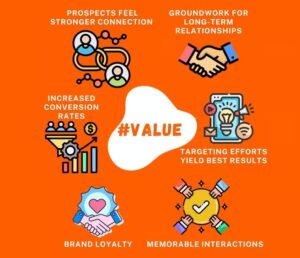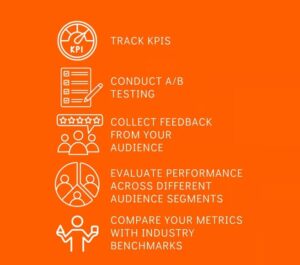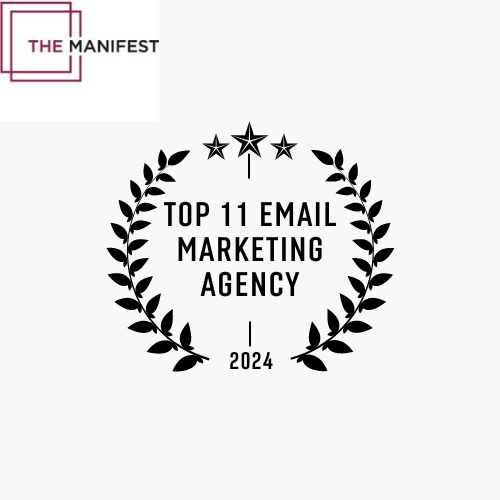In a landscape dominated by digital noise where mailing automation erases distinctions between customers, personalization is not just a buzzword anymore; it’s the key to understanding your audience and unlocking B2B lead generation and targeting success. This game-changer propels your targeting strategies from good to legendary and transforms prospects into lifelong customers. In this article, we will discover why personalization isn’t just a trend. Buckle up for insights, automation strategies, and a roadmap to turn the generic into the extraordinary. Get ready to delve into a world where every interaction feels tailor-made, and every lead is more than just a prospect—it’s a relationship waiting to blossom.
What is Personalization and Why Does It Matter?
Ever felt like a company was reading your mind? That’s the magic of personalization. Personalization in B2B LeadGen is the strategic targeting approach of tailoring interactions, automation, content, and outreach to meet the specific needs, preferences, and characteristics of individual prospects or target accounts. It’s about going beyond the generic one-size-fits-all automation messaging model and understanding your audience intimately through delivering content that resonates.
Personalization is crucial in B2B lead generation because it humanizes business interaction. It shifts the targeting focus from a generic sales pitch to a personalized conversation, establishing a deeper connection with prospects. Effective personalization starts with segmentation, making your outreach more meaningful and impactful. By understanding and addressing the unique pain points and challenges of individual businesses, personalization enhances the relevance and resonance of your messaging, even if it involves automation.
Picture this: Your leads don’t just open your emails; they eagerly await them. That’s the result of content personalization. Such content speaks directly to their challenges, needs, and dreams. It’s not just about selling and targeting; it’s about building relationships. Personalization makes your customers stick around.
Here are some of the main benefits of personalization for B2B Lead Generation:
Enhanced Engagement: Communication personalization captures attention and fosters engagement as prospects feel a stronger connection to tailored automation content.
Increased Conversion Rates: When automation messages resonate with the specific needs of a prospect, the likelihood of conversion significantly improves.
Improved Customer Satisfaction: By personalization, businesses build trust and satisfaction, laying the groundwork for long-term relationships.
Efficient Use of Resources: Personalization allows LeadGen for more efficient use of resources, focusing on targeting efforts where they are most likely to yield results.
Brand Loyalty: Tailored experiences and personalization create memorable interactions and targeting, fostering brand loyalty as customers appreciate the effort invested in understanding and meeting their needs.

Examples of Personalization in B2B
Let’s break down some real-world examples that turn generic outreach into conversation personalization.
1. Tailored Email Campaigns
Sending out automation emails is like casting a net in the ocean – it might catch something, but it’s not precision fishing. Instead, personalize those emails. Tailoring emails through segmentation ensures each message hits the right chord with specific groups. Use the recipient’s name, craft content that aligns with their industry, and throw in a dash of dynamic content. It’s like serving a dish made to order, not one-size-fits-all.
2. Personalization of Website Experience
Imagine walking into a store, and everything on the shelves speaks directly to your needs. That’s the online experience you want to create in your LeadGen targeting automation. Show content based on their previous visits, create landing pages tailored to specific industries, and guide them through a journey designed just for them.
3. Account-Based Marketing (ABM)
ABM is like having a conversation instead of shouting in a crowd. Craft targeting automation campaigns like love letters to specific accounts. Dive deep into their challenges, needs, and dreams. ABM becomes a masterpiece with segmentation. Identify high-value segments, personalize your approach, and craft campaigns that feel like bespoke experiences. It’s not a one-size-fits-all approach; it’s a bespoke strategy for each significant account.
4. Segmented Content Marketing
Not everyone in your audience is at the same stage. Segmentation reshapes your content strategy. Tailor your content accordingly. Create blog posts, whitepapers, and resources that speak to different phases of the buyer’s journey. It’s like offering a menu with options for every taste.
5. Personalized Social Media Interactions
On social media, be more than a brand – be a conversationalist. Tailor your LeadGen posts to suit the interests of your targeting audience. Engage in discussions, answer questions personally, and use platforms like LinkedIn to build connections on a professional level.
6. Interactive Content and Surveys
Make your targeting audience part of the process and take segmentation to the next level with interactive surveys. Use quizzes or assessments that provide personalization into recommendations. Surveys are your secret weapon; gather insights into their preferences and challenges. Then, respond with content or offers tailored just for them.
7. Dynamic Ad Campaigns
Static ads are so last season. Go dynamic. Craft automation campaigns that change based on your viewer’s behavior. If they’ve shown interest in a particular product, show them more of it. It’s like having a personal shopper who knows exactly what you’re looking for.
8. Sales Outreach Personalization
In Sales and LeadGen, personalization isn’t an option; it’s a necessity. Address your prospects by name, reference their pain points, and tailor your product demonstrations to their unique needs. Sales outreach becomes truly personalized with segmentation, addressing prospects based on their specific segment. It’s not just automation selling; it’s creating personalization of the shopping experience.
These examples aren’t reserved for marketing wizards. With the right automation tools and targeting strategy, any B2B brand can harness the power of personalization, turning generic outreach into a tailored, engaging experience for its audience. Ready to make your mark? Let’s get personal.
5 Most Common Tools for Personalization in B2B
Now let’s look at 5 most common tools and technologies available to enhance personalization. With these tools and technologies at your disposal, you’re equipped to craft personalization strategies that will resonate with your audience, turning leads into loyal advocates.
1. CRM Systems
Your Customer Relationship Management (CRM) system is the heart of personalization. It’s like having a digital dossier on every LeadGen prospect. Track their interactions, preferences, and history with your brand. This information is the automation compass guiding your personalization targeting strategy, ensuring every message hits its mark.
Here are some software examples of CRM systems for you to start using: Salesforce, HubSpot, Microsoft Dynamics
2. Predictive Analytics
Ever wished you had a crystal ball to predict your prospect’s next move? Enter predictive analytics. These tools analyze past behaviors to foresee future actions which make it easy for you to tailor your strategy. With these tools ensure you’re always one step ahead in delivering the right message at the right time.
Here are some predictive analytics software examples for you to start using: Infer, 6sense, EverString
3. Content Personalization Engines
Think of content personalization engines as your personal chefs for each targeting prospect. They analyze data to understand preferences and serve up content tailored to individual tastes. Whether it’s recommending articles, videos, or resources, these engines ensure your content speaks directly to your audience.
Here are some software examples of content personalization engines for you to start using: Acquia Lift, Evergage, Adobe Target
4. A/B Testing Tools
Personalization isn’t a one-size-fits-all; it’s an evolving art. A/B testing tools allow you to experiment with different personalization strategies. Test email subject lines, content variations, and CTAs to discover what resonates most with your audience. It’s the constant tweaking that leads to personalization perfection. Here are some software examples of A/B testing tools for you to start using: Optimizely, VWO, Google Optimize
5. Personalization Plugins and Widgets
Enhance your website’s personalization game with plugins and widgets. These nifty tools allow you to add dynamic targeting elements that change based on user behavior. In the segmentation landscape, each segment represents an opportunity for a unique and tailored interaction. These add-ons make your website a personalized playground for your audience, from recommendations personalization to interactive chatbots.
Here are some software examples of personalization plugins for you to start using: Barilliance, Monetate, Dynamic Yield
By leveraging these personalization tools and technologies, B2B businesses can implement effective personalization strategies, enhance customer experiences, and ultimately drive better results in lead generation, targeting and conversion.
How to Know Personalization Strategy Works?
So let’s imagine you are equipped with all the targeting tools and technologies and implement a new strategy of personalization in your work. However, how can you be sure it works and brings the exact value you expected? Well, numbers tell the story. Analyzing the data helps refine your personalization strategy, making it a dynamic, ever-evolving force that adapts to your audience’s needs. Here’s a guide on how to analyze personalization success effectively:
1.Define Key Performance Indicators (KPIs)
Establish clear KPIs aligned with your personalization goals and track them regularly. These may include conversion rates, engagement metrics, lead quality, and customer satisfaction. Define what success looks like for each personalization campaign or initiative.
2. Segmentation Analysis
Evaluate the performance of personalized targeting campaigns across different audience segments. Identify which segments respond most positively to personalization and adjust your strategy accordingly.
3. Compare personalized and non-personalized campaigns
Compare KPIs between personalized and non-personalized campaigns to understand whether the first one brings better results and more value. Then consider changing targeting approaches if needed.
4. A/B Testing and Iterative Improvements
Conduct A/B testing to compare the performance of different personalization elements, such as messaging, images, or calls-to-action. Use the results to iteratively improve your Lead Generation personalization strategy.
5. Feedback and Surveys
Collect feedback directly from your audience through surveys or feedback forms. Ask about their perception of personalization experiences and whether they find them valuable. Use this qualitative data to inform adjustments.
6. Benchmark Against Industry Standards
Compare your personalization metrics with industry benchmarks to gain a broader perspective on your performance. Identify areas where you outperform or areas that may require further attention.
Data is your targeting compass, guiding you to personalization perfection. Remember that personalization is an ongoing LeadGen process, and continuous analysis ensures that you stay responsive to evolving customer needs and market dynamics. Adjust, adapt, and watch those targeting charts go through the roof.

Recommended article related to Personalization in B2B Lead Generation:
Emerging Trends in B2B Lead Generation
In a Nutshell Conclusion – Why Do You Need Personalization?
In a B2B world drowning in generic noise, personalization is your golden ticket. It transforms your LeadGen approach from ‘selling’ to ‘connecting.’ Your audience isn’t a demographic; they’re individuals with unique needs, and personalization is your commitment to understand their needs, aspirations, and pain points, and to resonate with them. Embrace the targeting tools, and analyze the metrics, but never lose sight of the human touch. Armed with insights and armed with empathy, go forth and create personalization experiences that resonate in the hearts of your B2B audience.
Read another article by Veza Digital on the importance of Personalization in B2B Marketing.
Subscribe to our newsletter for more valuable content.



